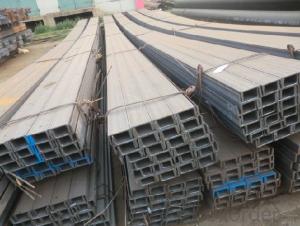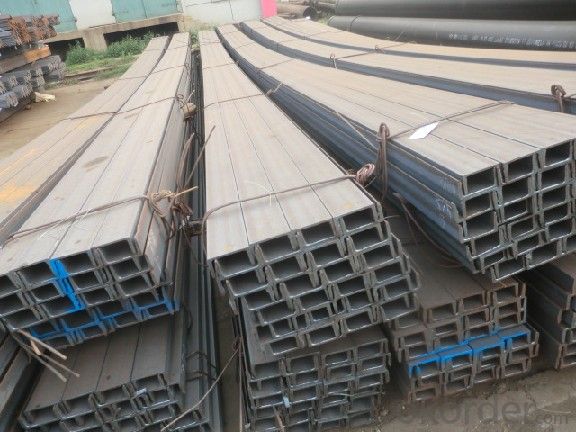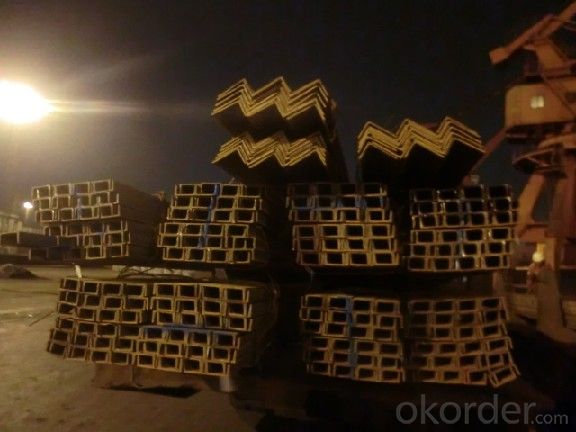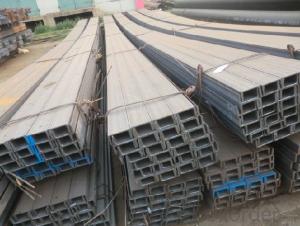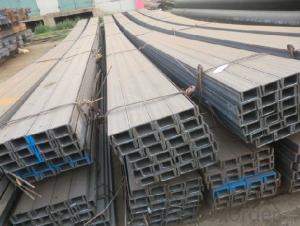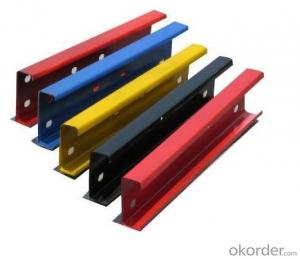hot channle and gb
- Loading Port:
- China Main Port
- Payment Terms:
- TT OR LC
- Min Order Qty:
- -
- Supply Capability:
- -
OKorder Service Pledge
OKorder Financial Service
You Might Also Like
Product Description:
Specifications of MS Channel:
1.We supply high quality MS Channel at reasonable price, including Chinese standard, Japanese standard and so on.
Standard | GB/JIS |
Material Grade | Q235,SS400 |
Technique: | Hot Rolled |
Sizes as per chinese standard: | 50*37*4.5mm - 300*89*11.5mm |
Sizes as per japanese standard: | 50*25*3mm – 200*80*7.5mm |
Length: | 6meter, 9meter, 12meter |
Note: 1.we are also competent to provide our customers other MS Channel based on other sizes according to customer’s requirements.
2. The length of our ms channel could be cut into other meters as per customer’s requirements. For example, the channel in 6meters could be cut into 5.8meters in order to be fit in the 20ft container.
2. The detailed sections of MS Channel as per GB standard.are shown in the table-1:
GB U CHANNEL | Standard | Sectional | Dimension |
| Mass: |
| (mm) | (mm) | (mm) | (mm) |
|
50X37 | 50 | 37 | 4.50 | 7.0 | 5.438 |
63X40 | 63 | 40 | 4.80 | 7.5 | 6.634 |
80x43 | 80 | 43 | 5.00 | 8.0 | 8.045 |
|
|
|
|
|
|
100x48 | 100 | 48 | 5.30 | 8.5 | 10.007 |
120x53 | 120 | 53 | 5.50 | 9.0 | 12.059 |
140x58 | 140 | 58 | 6.00 | 9.5 | 14.535 |
140x60 | 140 | 60 | 8.00 | 9.5 | 16.733 |
|
|
|
|
|
|
160x63 | 160 | 63 | 6.50 | 10.0 | 17.240 |
160x65 | 160 | 65 | 8.50 | 10.0 | 19.752 |
|
|
|
|
|
|
180x68 | 180 | 68 | 7.00 | 10.5 | 20.174 |
180x70 | 180 | 70 | 9.00 | 10.5 | 23.000 |
|
|
|
|
|
|
200x73 | 200 | 73 | 7.00 | 11.0 | 22.637 |
200x75 | 200 | 75 | 9.00 | 11.0 | 25.777 |
|
|
|
|
|
|
220x77 | 220 | 77 | 7.00 | 11.5 | 24.999 |
220x79 | 220 | 79 | 9.00 | 11.5 | 28.453 |
|
|
|
|
|
|
250x78 | 250 | 78 | 7.00 | 12.0 | 27.410 |
250x80 | 250 | 80 | 9.00 | 12.0 | 31.335 |
250x82 | 250 | 82 | 11.00 | 12.0 | 35.260 |
|
| |
|
|
|
280x82 | 280 | 82 | 7.50 | 12.5 | 31.427 |
280x84 | 280 | 84 | 9.50 | 12.5 | 35.823 |
280x86 | 280 | 86 | 11.50 | 12.5 | 40.219 |
|
|
|
|
|
|
300x85 | 300 | 85 | 7.50 | 13.5 | 34.463 |
300x87 | 300 | 87 | 9.50 | 13.5 | 39.173 |
300x89 | 300 | 89 | 11.50 | 13.5 | 43.883 |
Table-1
3. The chemical composition of HR Channel Steel according to Q235B is shown in Table-2.
Alloy No | Grade | Element(%) | ||||
C | Mn | S | P | Si | ||
Q235 | B | 0.12-0.20 | 0.3-0.7 | ≦0.045 | ≦0.045 | ≦0.3 |
Table-2
Note: we are able to present our customers relevant SGS test report for chemical composition of HR Channel Steel.
4. The mechanical property of HR Channel Steel according to Q235B is shown in Table-3-1 and Table-3-2
Alloy No | Grade | Yielding Strength Point(Mpa) | |||
Thickness(mm) | |||||
≦16 | >16-40 | >40-60 | >60-100 | ||
≧ | |||||
Q235 | B | 235 | 225 | 215 | 205 |
Table-3-1
Alloy No | Grade | Tensile Strength(Mpa) | Elongation After Fracture(%) | |||
| | Thickness(mm) | |||||
≦16 | >16-40 | >40-60 | >60-100 | |||
≧ | ||||||
G235 | B | 375-500 | 26 | 25 | 24 | 23 |
Table-3-2
Note: we are able to present our customers relevant SGS test report for mechanical property of MS Channel as customer’s request.
Applications of MS Channel:
The MS Channel can be applied to construction of warehouses, workshops, sport stadiums and car parks etc.The hot rolled channel steel belongs to carbon structural steel which is applied to in the field of construction and machinery.In details, the hot rolled channel steel is usually used for arch-itechtural structure, and they could be welded in order to support or hang a vari-ety of facilities. They are also usually used in combination with I beam. Generally,the hot rolled channel steel we supply must possess perfect welding property, riveting property and mechanical property and so on.
Package & Delivery of MS Channel:
1.The hot rolled channel steel will be packed in bundle with steel wire at each end of every bundle and color marking in order to help the customer to recognize his goods more easily at sight.
2. And the hot rolled channel steel could be loaded into 20ft or 40ft container, or by bulk cargo.If the weight of each bundle reaches more than 3.5 mt, the loading by break bulk cargo should be choosed.When the weight of each bundle reaches less than 3mt, the loading by container should be choosed.
3.As for the transportaion from mill to loading port, the truck will be usually used. And the maximum quantity for each truck is 40mt.
4.All in all, we could do in accordance with customer's request
- Q: Are steel channels suitable for sports facility construction?
- Indeed, sports facility construction can indeed utilize steel channels. Due to their robustness and endurance, steel channels are frequently employed in the construction field. They offer structural reinforcement and possess the capacity to endure substantial loads, rendering them an optimal choice for sports facilities that necessitate extensive open spaces and the ability to accommodate a sizable crowd. Steel channels can be employed in the development of grandstands, bleachers, and other seating areas, as well as in the framing of structures such as roofs and walls. Furthermore, steel channels exhibit resistance to corrosion, thereby establishing them as a dependable option for sports facilities that may be exposed to outdoor elements. Their adaptability and ease of customization and fabrication to comply with precise design requirements contribute to the widespread utilization of steel channels in sports facility construction.
- Q: How do steel channels contribute to the energy efficiency of a building?
- Steel channels contribute to the energy efficiency of a building in several ways. Firstly, steel channels can be used to create structural frames and support systems, which help distribute the weight of the building evenly and efficiently. This allows for more open and flexible floor plans, reducing the need for additional support columns and walls. By minimizing the use of materials, steel channels help optimize the use of space and reduce the overall energy consumption required for construction. Additionally, steel channels are known for their high strength-to-weight ratio, which means they can support heavy loads while having a relatively low weight themselves. This property allows for the construction of taller and larger buildings, maximizing the usable space without compromising on structural integrity. As a result, more occupants can be accommodated within a smaller footprint, leading to greater energy efficiency in terms of land use. Steel channels also contribute to energy efficiency through their durability and longevity. Steel is a highly durable material that can withstand extreme weather conditions, resist corrosion, and remain structurally sound over time. This reduces the need for frequent repairs and replacements, resulting in lower maintenance costs and less energy consumption associated with building maintenance. Furthermore, steel channels can be used as part of an efficient insulation system. Insulated steel channels can be integrated into the building envelope, providing a thermal barrier that helps regulate indoor temperature. This insulation reduces the reliance on heating and cooling systems, resulting in lower energy consumption and improved energy efficiency. Lastly, steel channels are often made from recycled steel, which has a significantly lower carbon footprint compared to the production of virgin steel. By using recycled materials, the environmental impact of the building's construction is reduced, contributing to overall energy efficiency. In conclusion, steel channels contribute to the energy efficiency of a building by enabling efficient structural designs, optimizing space utilization, providing durability and longevity, supporting insulation systems, and utilizing recycled materials. These factors collectively reduce energy consumption, improve building performance, and contribute to a more sustainable and environmentally friendly construction industry.
- Q: Can steel channels be used in the construction of retaining walls?
- Absolutely, retaining walls can incorporate steel channels. These durable and strong structural components are commonly utilized in a range of construction endeavors. When integrated into retaining walls, they offer enhanced reinforcement and stability. Whether employed as vertical or horizontal supports, steel channels effectively distribute the load and thwart soil erosion. Moreover, their resistance to weathering and corrosion makes them an ideal long-term choice for retaining walls. Nonetheless, it is crucial to factor in the project's unique design prerequisites and seek guidance from a structural engineer to guarantee the accurate size, spacing, and positioning of the steel channels.
- Q: Can steel channels be used in mezzanine floors?
- Yes, steel channels can be used in mezzanine floors. Steel channels, also known as C-channels or U-channels, are commonly used as structural elements in construction. They are versatile and can provide strength and support for mezzanine floors. Steel channels can be used as joists or beams to create the framework for the mezzanine floor, providing a sturdy and durable structure. Additionally, steel channels can be easily customized and fabricated to meet specific design requirements, making them suitable for various mezzanine floor applications.
- Q: Can steel channels be used for creating storage racks or shelving units?
- Absolutely, storage racks or shelving units can definitely be created using steel channels. Steel channels are renowned for their robustness and resilience, which makes them perfect for bearing substantial weights. They are effortlessly fabricated and assembled to produce durable and enduring storage solutions. The adaptability of steel channels permits customization and adjustment to fit precise storage demands, such as adjustable shelving heights or various rack arrangements. Furthermore, steel channels can endure demanding surroundings, such as warehouses, garages, or industrial settings, guaranteeing the stability and security of the storage racks or shelving units.
- Q: Are steel channels suitable for high-traffic areas?
- Yes, steel channels are suitable for high-traffic areas. Steel channels are known for their durability, strength, and resistance to wear and tear. They can withstand heavy loads and frequent foot traffic without deforming or breaking, making them ideal for areas with high pedestrian or vehicular traffic. Additionally, steel channels are often designed with anti-slip features, providing extra safety in high-traffic areas where there is a risk of slipping or falling. Overall, steel channels offer a reliable and long-lasting solution for high-traffic areas.
- Q: Can steel channels be used in the automotive parts manufacturing industry?
- Yes, steel channels can be used in the automotive parts manufacturing industry. Steel channels are commonly used in the automotive industry for various applications such as structural components, frames, body panels, reinforcements, and chassis parts. Steel channels offer high strength and durability, making them suitable for withstanding the demanding conditions and loads experienced by automotive parts. Additionally, steel channels can be easily shaped, cut, and welded, allowing for efficient customization and fabrication of automotive components. The use of steel channels in the automotive parts manufacturing industry helps ensure the production of robust and reliable automotive parts.
- Q: Can steel channels be used for creating support structures for ventilation systems?
- Support structures for ventilation systems can be created using steel channels. These channels are widely used in construction and engineering because of their durability and strength. They offer a solid framework for supporting the weight of ventilation equipment, including fans, filters, and ductwork. Moreover, steel channels provide design flexibility and can be tailored to meet specific project needs. Furthermore, steel is resistant to corrosion and can withstand harsh environmental conditions, making it suitable for use in moisture or chemical-exposed ventilation systems. Ultimately, steel channels are a dependable option for establishing support structures that guarantee the secure and effective functioning of ventilation systems.
- Q: British standard I-beam 203*203*46 size
- The main specifications of the available contour I-beam section size (mm) expressed in high waist leg width (H) * (b) * (d) mm thick waist numbers, such as I160 x 88 x 6, namely said waist height 160mm, waist leg width 88mm, thickness 6mm i-beam. I-steel specifications are available models (Tex) said, showing the type of waist high number of centimeters, such as waist high 160mm I-beam type I 16#. The same as the waist high beam, there are several different leg width and waist thick, need to add code in the model (also known as the right corner) a or B or C to make a difference, such as 32a#, 32b#, 32c# etc..
- Q: What are the different methods for cutting steel channels?
- There are several methods for cutting steel channels, each with its own advantages and disadvantages. Some of the most common methods include: 1. Sawing: This method involves using a circular saw or bandsaw to cut through the steel channel. It is a versatile method that can be used for both straight cuts and angled cuts. However, it can be time-consuming and may produce a rough finish that requires further processing. 2. Shearing: Shearing is a process that involves using a specialized machine called a shear to cut through the steel channel. It is a fast and efficient method that produces clean and precise cuts. However, it is limited to straight cuts and may not be suitable for thicker or larger steel channels. 3. Cutting torch: A cutting torch uses a high-temperature flame to melt and cut through the steel channel. It is often used for thicker or heavier steel channels and can produce smooth and precise cuts. However, it requires skilled operators and can be more time-consuming than other methods. 4. Plasma cutting: Plasma cutting involves using a plasma torch to cut through the steel channel. It is a fast and accurate method that can be used for both straight cuts and intricate shapes. However, it requires specialized equipment and may produce a heat-affected zone that requires further processing. 5. Waterjet cutting: Waterjet cutting uses a high-pressure stream of water mixed with abrasive material to cut through the steel channel. It is a precise and versatile method that can produce clean and accurate cuts in various materials and thicknesses. However, it can be expensive and may require skilled operators. 6. Laser cutting: Laser cutting uses a focused laser beam to cut through the steel channel. It is a highly precise method that can produce intricate cuts with minimal heat-affected zone. However, it can be costly and may require specialized equipment and operators. It is important to consider the thickness, size, and complexity of the steel channel, as well as the desired finish and the available resources, when choosing the appropriate method for cutting.
Send your message to us
hot channle and gb
- Loading Port:
- China Main Port
- Payment Terms:
- TT OR LC
- Min Order Qty:
- -
- Supply Capability:
- -
OKorder Service Pledge
OKorder Financial Service
Similar products
Hot products
Hot Searches
Related keywords
